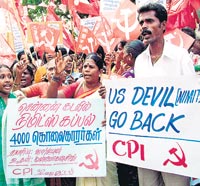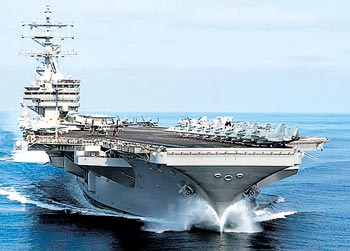
USS Nimitz in Chennai: What perils does it bring in its wake?The USS Nimitz and several other American warships left San Diego on April 2 for the Persian Gulf to join another locally based aircraft carrier strike group already in the region. The same USS Nimitz came calling at the port of Chennai (formerly Madras) on the south-eastern coast of India on July 1. On both occasions, the US Navy refused to rule out the presence of nuclear weapons on board the nuclear-powered vessel. Deployment of the Nimitz in the Gulf came amidst a crisis over the detention of 15 British sailors and Marines by Iran, which charged that they were operating in its territorial waters. Iran released them later, but has not withdrawn its charge. The warship, it was made clear then, would have a wider area of operation, which obviously included Iraq, though the mission to India was months away. Nimitz had been deployed in support of the so-called Operation Iraqi Freedom as far back as 2003.
A Navy statement then declared that the Nimitz would support the "war on terrorism," patrol the Horn of Africa and conduct marine security operations as part of the larger effort to "deter and dissuade others from acting counter to US national interests." The Chennai port call of the warship, on the other hand, was to encourage India to continue acting in "US national interests" as Washington, and not the American people, perceived them. The ship's visit to Chennai, according to the Navy, attests to the growing vista of "military relations" between the two countries. It is expected to strengthen the US-India "strategic partnership," supposed to have been deepened already by a nuclear "deal." Neither the "partnership" nor the "deal" can reassure either the peace-loving people of India or its neighbours of varying degrees of proximity. The first reaction here to the news about the impending Nimitz visit was fear of a serious radioactive threat to the teeming millions on the placid shores of the azure and tranquil Bay of Bengal. The apprehensions were not really allayed by the report that a "crisis management group" of India's Department of Atomic Energy (DAE) was "keeping a close watch" on the ship and ready with plans to cope with any "emergency." The fear, in fact, was aggravated, and not only because the official claim was a confession of the possibility of the euphemistically so-called "emergency." The DAE does not enjoy high credibility in such matters. It has refused to consider questions raised by the tsunami attack of 2004 on the Kalpakkam nuclear complex and township close to the city. It does not inspire implicit trust in fishermen, after dismissing their objections at a "public hearing" to plans for the expansion of another nuclear complex in Koodankulam in the southern State of Tamilnadu. A public relations blitzkrieg, to smooth the waves for the warship, preceded the arrival of Nimitz. We were told that it had cruised the global waters for 56 years without any grave consequence (if you count out the massacres it may have helped to cause inside Iraq). A local scientist certified that he had been on board a similar ship and found it quite safe. There has been no Hiroshma after 1945, but does that make nuclear weapons in the US arsenal (or any other) safe? People in the region around Chernobyl felt secure for years before that stupendous accident, but is it not a charred memory now? The fear was not stilled either when Rear Admiral John Terence Blake, commander of the carrier strike group, told the media: "We can neither confirm, nor deny the presence of weapons on board the ship." He added, without even an attempt at reassurance: "These are warships, not cruise liners. When we go out, we are required to perform a wide range of activities, and these can be offensive or defensive."
There was a possibility, of course, that the port call would pass off without any accident. Nimitz may have really carried no nuclear weapons, though the US Navy seems to claim a right to carry them through international waters. The main danger that the warship's visit posed, however, was the prospect of India becoming a closer strategic partner of the warlords in Washington and the Pentagon. It was this danger that drew hundreds of protesters to a mass demonstration at the main gate of the Chennai harbour on July 2. The angry Chennai citizens did not stop with asking the Nimitz to go back. They also asked New Delhi why it had reversed its policy of not entertaining ships that could be carrying nukes close to its territorial waters. They asked what India could gain by allying militarily with Bush-led, bloodthirsty warmongers guilty of grisly war crimes. The questions came as a logical corollary to the statement of the US Consulate in Chennai describing the ship's visit as "part of a bilateral and multilateral framework known as the 'Malabar series' of joint Indo-US exercises." The series, initiated in 1992, has spelt more frequent joint exercises ever since 9/11 and the tacit US inclusion of India in its idea of an international "alliance against terror." This alliance led to an analogous situation on November 7, 2005 in another part of India. On that day, the peace of a village in the eastern and Left-ruled state of West Bengal was disturbed by the sudden eruption of a dogfight between US and Indian fighter planes. "The mock battle over paddy fields," I reported then, "was greeted by tens of thousands of militant demonstrators below with slogans asking the Bush air force to go back." The report, titled "Why India-US War Games Cause Wide Concern", talked of what the exercise code-named Cope India meant for peace in the entire region. The drills had an unmistakable anti-Pakistan dimension, for example, with the Americans employing F-16s and "giving an opportunity to our air warriors" (as an Indian security expert enthused) to practice against Pakistanis equipped with the same fighter planes. This rapid development of military relations had a naval dimension as well. The Indian Navy did not endear itself to Southeast Asian countries and governments by joining the US in the "search" and "anti-piracy" operations in the Straits of Malacca. This foreshadowed the concerted campaign by the Bush regime for a Proliferation Security Initiative (PSI), which envisages high-handedness on high seas by the US and its band of "counter-proliferation" crusaders. New Delhi has never concealed its keenness to be counted among these crusaders, especially if the PSI could be turned into a US-India alliance against Pakistan as a promoter of nuclear proliferation. The Malabar exercises, recalled by the US Navy on the occasion of the Nimitz visit, are said to exemplify Washington's desire to give India "a key role in fighting global terror." US Ambassador to India David Mulford has seized the Nimitz-given opportunity to invite India into yet another Bush "initiative" that cannot make this country a darling of the developing world. Said Muford on July 3: "Our collaboration, which the United States runs out of President Bush's Global Peacekeeping Operations Initiative, will help build crucial capacity for addressing leadership needs for peacekeepers around the world." The crusade for such "peace," of course, will be incomplete if it does not serve the US corporate interests. From a preacher of "peacekeeping," Mulford took but a moment to turn into a salesman for the military-industrial complex. Talking of a "new era of defense cooperation," he recalled that India had purchased last year the troop carrier USS Trenton -- now renamed INS Jalashwa. Ha added: "At the moment, we are discussing the possible sale to India of C-130 aircraft, the celebrated workhorse of multi-role lift airplanes with the longest continuous production run of any military aircraft." He, of course, did not mention the price the poor of India -- and South Asia, considering the arms race all this will cause -- will have to pay for this alleged cooperation for peace. The Nimitz was scheduled to leave India's shores after a four-day visit. But the people and the peace movement of India will have to battle the perils this warship has brought in its wake. Courtesy truthout.org.
(A freelance journalist and a peace activist of India, J. Sri Raman is the author of Flashpoint (Common Courage Press, USA). He is a regular contributor to truthout.org) |
|| Front
Page | News | Editorial | Columns | Sports | Plus | Financial
Times | International | Mirror | TV
Times | Funday
Times || |
| |
Copyright
2007 Wijeya
Newspapers Ltd.Colombo. Sri Lanka. |

